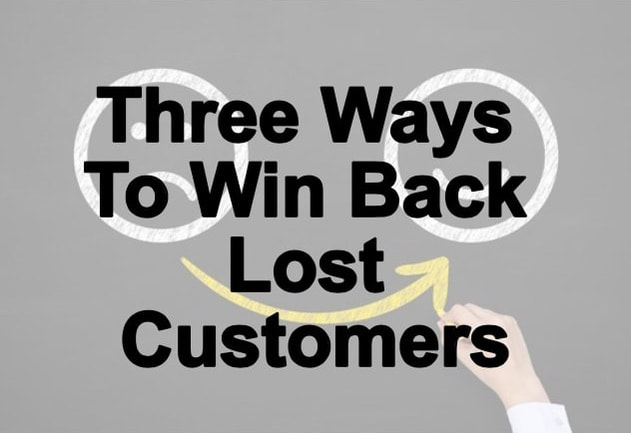This post originally ran on Forbes.com.
Are you looking for ways to win back lost customers? If so, you’re not alone. Brands across all industries want to keep customers engaged for as long as possible.
There are plenty of advantages that come with building an audience that’s loyal to your brand. For starters, you can save money and increase your profits. It can cost five to 25 times more to acquire a new customer than it does to retain an existing one. And I've noticed that long-term customers are likely to spend more when they place an order.
The percentage of people who stop using your product or service in a given time period is known as your churn rate. You can calculate this by dividing the number of customers you lost by the total number of customers you had at the beginning of the time period and multiply by 100. So, if your business has 200 customers at the beginning of the month and 20 stop using your product, you have a churn rate of 10% that month.
Companies with a high customer churn rate often have smaller profit margins and see mixed reviews on social platforms. As a business owner or marketer, keeping your churn rate low is crucial to your success.
Below are several ways you can win back customers when they stop placing orders or responding to your emails. I started using these strategies back in 2016 when I co-founded my company. We've since grown exponentially and even acquired a few new brands along the way.
Are you looking for ways to win back lost customers? If so, you’re not alone. Brands across all industries want to keep customers engaged for as long as possible.
There are plenty of advantages that come with building an audience that’s loyal to your brand. For starters, you can save money and increase your profits. It can cost five to 25 times more to acquire a new customer than it does to retain an existing one. And I've noticed that long-term customers are likely to spend more when they place an order.
The percentage of people who stop using your product or service in a given time period is known as your churn rate. You can calculate this by dividing the number of customers you lost by the total number of customers you had at the beginning of the time period and multiply by 100. So, if your business has 200 customers at the beginning of the month and 20 stop using your product, you have a churn rate of 10% that month.
Companies with a high customer churn rate often have smaller profit margins and see mixed reviews on social platforms. As a business owner or marketer, keeping your churn rate low is crucial to your success.
Below are several ways you can win back customers when they stop placing orders or responding to your emails. I started using these strategies back in 2016 when I co-founded my company. We've since grown exponentially and even acquired a few new brands along the way.
1. Find Out Why You Lost Them
First, find out why they decided to stop ordering or responding in the first place. If you can get to the bottom of the issue, you’ll have a much easier time figuring out your next course of action.
For instance, if someone stopped buying from you because they found a better deal on a competitor site, you could send a coupon code that gives them a special price on their next order. Small incentives go a long way toward retaining customers.
You can easily find out why customers are leaving by sending an exit survey to email subscribers. When someone goes a specific period of time without completing an order, or cancels their membership, send a short survey with targeted questions. You could ask them what your company could do to get them to stay.
Alternatively, you could create a form that pops up when a customer is getting ready to abandon their shopping cart. These forms should only have one or two questions. Both questions should directly relate to their decision to leave and what you can do to change their mind.
For instance, if someone stopped buying from you because they found a better deal on a competitor site, you could send a coupon code that gives them a special price on their next order. Small incentives go a long way toward retaining customers.
You can easily find out why customers are leaving by sending an exit survey to email subscribers. When someone goes a specific period of time without completing an order, or cancels their membership, send a short survey with targeted questions. You could ask them what your company could do to get them to stay.
Alternatively, you could create a form that pops up when a customer is getting ready to abandon their shopping cart. These forms should only have one or two questions. Both questions should directly relate to their decision to leave and what you can do to change their mind.
2. Make Returning Worth Their Time
Once you understand why customers are leaving, you can start taking action to make returning worth their time. At my company, we like to publish three to five blog posts every week so customers have a reason to come back to our site that doesn’t require them to spend money. Consumers should see your site as an experience and not a simple visit to a store. Content marketing is the perfect way to connect with your audience and give them one more reason to stay loyal to your brand.
You can also entice customers into returning by frequently updating your website. Every business is slightly different, so your updates may vary depending on your budget and industry.
Website users are often receptive to design changes. If you see that most people who filled out abandonment forms cited a slow checkout page as their reason for leaving, a revamp could be the thing that brings them back for future orders.
When you make substantial changes to your products, features or website design, don’t forget to email your subscribers and let your social media followers know. If a former customer is still following your brand or subscribed to your list, they will see the message and they could come back to place a new order.
You can also entice customers into returning by frequently updating your website. Every business is slightly different, so your updates may vary depending on your budget and industry.
Website users are often receptive to design changes. If you see that most people who filled out abandonment forms cited a slow checkout page as their reason for leaving, a revamp could be the thing that brings them back for future orders.
When you make substantial changes to your products, features or website design, don’t forget to email your subscribers and let your social media followers know. If a former customer is still following your brand or subscribed to your list, they will see the message and they could come back to place a new order.
3. Create Personalized Campaigns
So, you’ve figured out why customers are leaving and made changes designed to bring them back; what’s next? The next step is creating personalized campaigns that are designed to bring customers back to your website.
Earlier, I mentioned sending coupon codes to customers who found a better deal elsewhere. This tactic is just one example of how you can personalize retention strategies for each person.
In many cases, email subscribers will not come back and buy something after just one email. You have to build up their trust in your brand again. You could segment your audience based on their interests and last interactions and create a re-engagement campaign.
Let’s say you own an online pet supply store and want to reach your inactive email subscribers. First, pull all inactive subscribers who haven’t opened an email in at least six months. The key is to keep them in their designated segments. In other words, all of the inactive customers interested in dogs would go to one group, and those interested in cats would go to another.
Now, you can create a campaign where you send relevant content and offers to the subscribers. I also suggest personalizing the headlines so they can see that you know they haven’t interacted with your brand in a long time. Headlines like “Was it something we said?” are eye-catching and can bring inactive subscribers back to your site.
As business owners and marketers, we have to admit that we won’t convince everyone to keep using our products or services. Use these tips to put the odds in your favor and win back more customers.
Earlier, I mentioned sending coupon codes to customers who found a better deal elsewhere. This tactic is just one example of how you can personalize retention strategies for each person.
In many cases, email subscribers will not come back and buy something after just one email. You have to build up their trust in your brand again. You could segment your audience based on their interests and last interactions and create a re-engagement campaign.
Let’s say you own an online pet supply store and want to reach your inactive email subscribers. First, pull all inactive subscribers who haven’t opened an email in at least six months. The key is to keep them in their designated segments. In other words, all of the inactive customers interested in dogs would go to one group, and those interested in cats would go to another.
Now, you can create a campaign where you send relevant content and offers to the subscribers. I also suggest personalizing the headlines so they can see that you know they haven’t interacted with your brand in a long time. Headlines like “Was it something we said?” are eye-catching and can bring inactive subscribers back to your site.
As business owners and marketers, we have to admit that we won’t convince everyone to keep using our products or services. Use these tips to put the odds in your favor and win back more customers.
.png?width=180&height=65&name=Untitled%20design%20(29).png)




